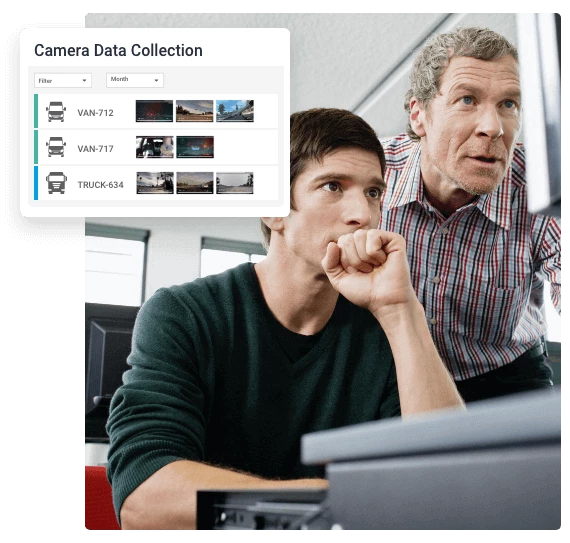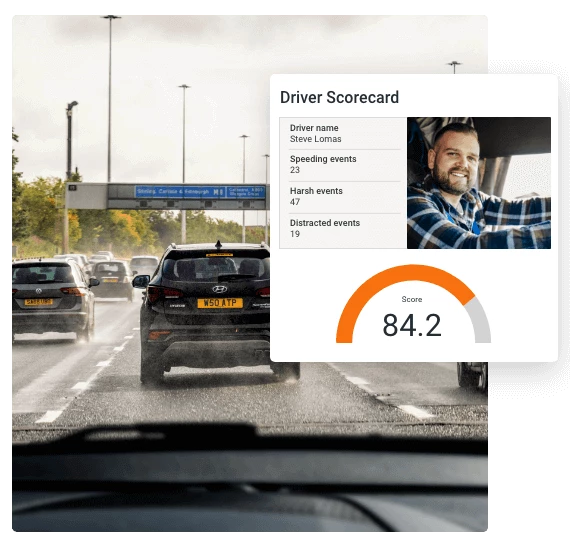Key Takeaways
Cameras are everywhere. They have revolutionised industries from healthcare and manufacturing to retail and transport. Implementing dash cams into your fleet management software will bring unprecedented levels of visibility into your business. But choosing the right technology partner is almost as important as the camera itself.
In this article, we will discuss:
- Finding the right integrated in-vehicle camera solution for your business
- Planning and communication
- Building success and incentive plans
- Benefits of a successful implementation
This article will guide you through the steps to take when choosing cameras, provide advice on ways to get driver adoption and what benefits you should expect to see.
So, let’s get started.
Understand Goals
The first step towards selecting an integrated cameras that’s right for your fleet is to understand your objectives and set proper goals. Don't just make the decision for the entire business - involve those that will use the system daily. What are the current pain points? What is the motivating factor behind installing dash cams? How the footage collected can help your role in the business? Most businesses implement multi cameras systems to help improve driver safety, but the benefits of the right technology can go beyond this and drive improvements in productivity, cost reduction, compliance and vehicle ownership cost.
Setting the right goals, both short and long-term, and implementing structures to track and measure key performance indicators is one of the most critical elements of a successful implementation and this should be a consideration when choosing a supplier. You should look for a partner that takes the time to understand your goals, has a proven track record of helping customers build solutions that meet their objectives and can demonstrate its capabilities to support onboarding and ongoing training.

How to choose the right fleet dash cam
Dash cams and in-vehicle camera solutions, provide numerous benefits to fleets, including improved driver safety, reduced on-road incidents, and lower insurance costs. But with so many systems on the market, from off-the-shelf systems, consumer-grade packages to professional customised solutions, picking the right cameras can be a challenge. When looking for a solution that can work across a fleet, one of the keys to success is integration, and how well the dash cams connect into fleet management software.
To achieve maximum ROI, your fleet dash cam system should integrate seamlessly with your fleet management software. This includes capturing footage of driving incidents, such as harsh braking, speeding, harsh cornering, and more, and pairing that data with your fleet tracking solution. You should be able to easily view recordings of these incidents from your fleet management software for use in driver training and de-briefs.

What to look for in a fleet camera system
The good news? There are many options from which to choose. Here are a few of the most essential features to consider:
- Fully Integrated: It is important that your cameras integrate into your fleet management software. You should be able to easily view recordings of events recorded by your telematics system without having to search for recordings based on event times.
- Constantly rolling: Your cameras should be recording all drive time enabling the AI engine to continually learn and report on dangerous and positive driver behaviour.
- Event Recording: The ability to automatically save the footage for all recorded driver events including, harsh braking, acceleration, and cornering. Recordings should be instantly available for all events or for specific timeframes.
- Connectivity: Fully integrated cameras should have 4G connectivity for real-time visibility.
- HD Video: High-definition video at a high frame rate (30fps or greater) is important when it comes to reviewing footage of incidents. Footage with grain or blur is unhelpful and a high frame rate means you see more within the footage you’re presented.
- Night vision: Cameras that do not work in low-light environments limit use.
- Multiple configurations: Front- and driver-facing cameras may be important depending on your goals and a multi-camera system can provide a comprehensive view around the vehicle.
- In-cab alerts: Built-in speaker for automatic feedback and alerts to help drivers with training and driver coaching.
- Privacy Considerations: It is important that your camera solution is flexible enough to record the footage required for you to meet your objectives and nothing more, offering drivers the functionality to retain as much privacy as possible can significantly help with adoption.
Team Communication
Communication is integral to the success of any technology implementation. While there has been a shift in the perception of drivers towards in-cab safety tools, many organisations can struggle when implementing new technologies. Communication, both prior to implementation and after the technology has been deployed is vital to achieving the goals of the system being implemented.
Integrated fleet dash cams are no different, and we have outlined three communication tips for your implementation.
- Cameras are not the enemy: Encouraging drivers to fully understand the purpose of the cameras - to gain insight into driving behaviours and on-road incidents, not be Big Brother - is essential.
- Show, don’t tell: Connecting the dots between what happens in cab and what fleet managers see on the back end is an essential aspect of winning driver support. Showing drivers exactly how the system works, what information is collected, and how the information is used goes a long way.
- Be transparent: One major concern for drivers, especially long-haul drivers who spend a lot of personal time in their rigs, is what’s being recorded and when. Transparency in your organisation’s video collection policy is key. Let drivers know when they are and are not being recorded, how that footage is used, and how long it is retained.

Develop success and incentive plans
When it comes to implementing any new technology, a plan is crucial. As the saying goes, failing to plan is planning to fail. Taking the extra steps to ensure everyone is on the same page will save headaches down the road.
Success starts with adoption
Technology is not a silver bullet - it’s only as good as you can use it. The key to the successful adoption of any new technology is proper training and it is important that you choose an integrated dash cam provider with a proven track record of training and onboarding for both fleet managers and drivers.
Incentivise drivers to perform
We often see implementation success when businesses use league tables that score driver performance against metrics that align with the business's overall objective. Driver scorecards are often included as part of fleet management systems and can be used alongside cameras to provide valuable feedback and training. The video recordings help turn numbers to context and provide real world examples of dangerous events.

Benefits of a Successful Fleet Dash Cam Implementation
The benefits of successfully implementing integrated multi-cameras system into your fleet management system include:
- Better visibility into on-road incidents - See how incidents unfold with real-time HD footage and use for situation training with your drivers.
- Improved driver safety - Identify and correct unsafe driving behaviours within your fleet, improving driver safety, reducing risk, and improving driver retention.
- Improved training, coaching and induction processes - you can make driver training more impactful with real life use cases and personalised programs built around an individual driver’s behaviour.
- Reduced costs - Save on fuel and maintenance costs with real-time driver coaching and alerts that correct the behaviours that lead to unnecessary wear and tear.
- Improved reputation - Maintain your brand’s image and reputation by correcting bad habits and incentivising drivers to perform better on the road. An increased reputation also leads to more work won for the business.
- Lower insurance premiums - protect your business from not at fault claims and improve your claims history.
Fleet dashboard cameras that are fully integrated into your fleet tracking system are vital to the performance and management of your fleet, but driver buy-in is key. Once you’ve picked the right system for your organisation based on your specific goals, training and communication will help ensure success.
